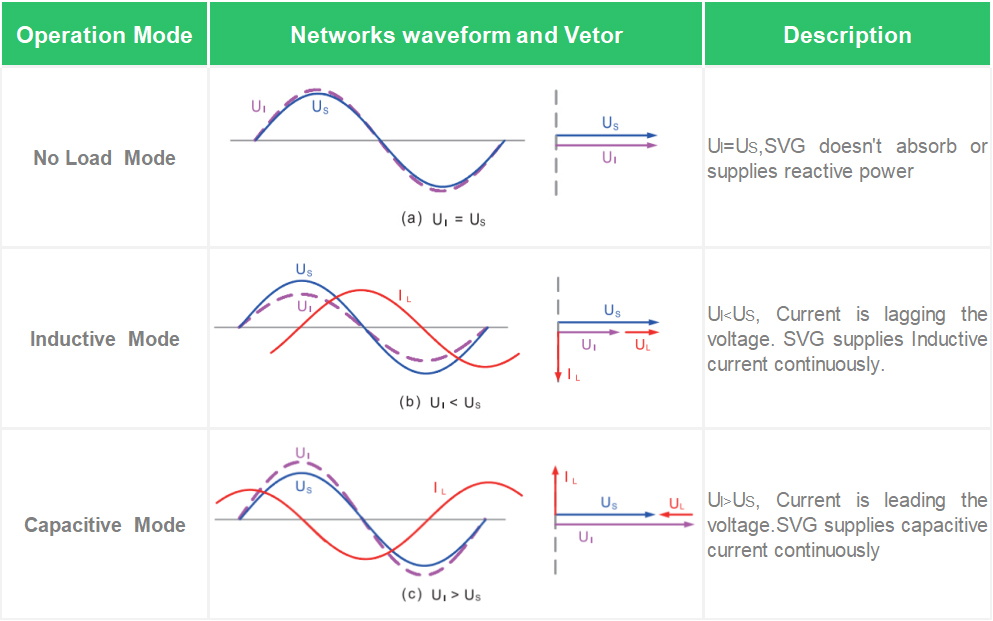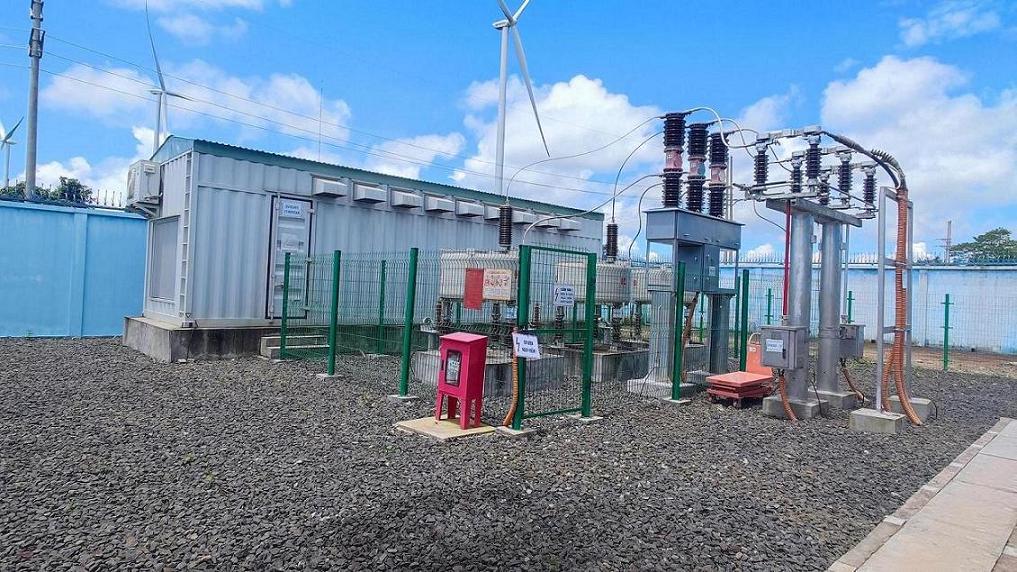

STATCOM (Static Synchronous Compensator) plays a crucial role in maintaining voltage stability in power systems by dynamically injecting or absorbing reactive power (VARs). Its ability to regulate voltage levels makes it essential for improving power quality, especially in grids with high renewable energy penetration or heavily loaded networks,mainly in medium or high voltage networks.
STATCOM (Static Synchronous Compensator) is a power electronics-based device used in electrical power systems to provide fast-acting reactive power compensation, voltage regulation, and stability enhancement. It is a member of the Flexible AC Transmission System (FACTS) family and is widely used in modern power grids to improve power quality and system efficiency.
A STATCOM consists of a Voltage-Source Converter (VSC), a DC capacitor, and a coupling transformer.
The VSC generates an AC voltage in phase with the grid but with adjustable magnitude.
If the output voltage is higher than the grid voltage, it injects capacitive reactive power (leading).
If the output voltage is lower, it absorbs inductive reactive power (lagging).
The DC capacitor provides the necessary energy storage for the converter.

Reactive Power Compensation
Generates or absorbs reactive power (VARs) dynamically to maintain voltage stability.
Unlike traditional SVCs (Static VAR Compensators), STATCOMs use voltage-source converters (VSCs) for smoother and faster response.
Voltage Regulation
Maintains bus voltage at a desired level by injecting or absorbing reactive power.
Helps mitigate voltage sags, swells, and flicker.
Dynamic Performance
Faster response compared to mechanical switches and thyristor-based compensators (response time in milliseconds).
Effective in damping power oscillations and improving transient stability.
No Need for Large Capacitors/Reactors
Uses DC capacitors and power electronics (IGBTs/GTOs) instead of bulky passive components.
Black Start Capability
Some STATCOMs can help restore power in case of a blackout by providing reactive power support.
STATCOMs (Static Synchronous Compensators) and SVCs (Static VAR Compensators) both provide reactive power compensation, but STATCOMs offer superior performance in modern power systems. Below is a detailed comparison:
| Device | Response Time | Implications |
| STATCOM | < 1 cycle (5–10 ms) | Better for transient stability, flicker mitigation, and rapid voltage control. |
| SVC (TCR/TSC) | 2–4 cycles (40–100 ms) | Slower due to thyristor switching delays. |
✅STATCOM wins → Essential for wind/solar farms, HVDC links, and weak grids needing ultra-fast corrections.
| Device | Behavior During Voltage Dips |
| STATCOM | Maintains full reactive current even at very low voltages (down to 0.2 pu). |
| SVC (TCR/TSC) | Reactive power output drops with voltage² (P = V²/X). |
✅STATCOM wins → Critical for fault ride-through (FRT) in renewables and preventing blackouts.
| Device | Components | Space Requirement |
| STATCOM | Voltage-Source Converter (VSC) + DC capacitor | Compact (30–50% smaller than SVC). |
| SVC (TCR/TSC) | Thyristor-controlled reactors (TCR) + capacitor banks | Bulky (large reactors & capacitors needed). |
✅STATCOM wins → Ideal for urban substations, offshore platforms, and mobile installations.
| Device | Harmonic Generation | Filter Requirements |
| STATCOM | Low (PWM-controlled, <3% THD) | Minimal filtering needed. |
| SVC (TCR/TSC) | High (5th, 7th harmonics) | Requires bulky filters. |
✅STATCOM wins → Reduces filter costs and avoids resonance issues with grid impedance.
STATCOM can be designed for direct medium-voltage (MV) connection (e.g., 11–33 kV).
SVC often requires additional step-up transformers for MV/HV grids.
✅STATCOM wins → Lower equipment costs & losses.
| Device | Reactive Power Transition |
| STATCOM | Seamless (continuous control) – No delay between capacitive/inductive modes. |
| SVC (TCR/TSC) | Step-wise (TSC switching delays) – Limited by capacitor bank sizes. |
✅STATCOM wins → Smoother voltage regulation & better grid stability.
STATCOM has lower losses (~1–2%) compared to SVC (2–4%), especially at low loads.
SVC suffers from fixed reactor losses even when idle.
✅STATCOM wins → Better for energy savings in variable-load systems.

| Feature | Statcom | SVC |
| Speed | Faster (ms)✅ | Slower (cycles) |
| Low-Voltage Support(LVRT) | Excellent✅ | Poor |
| Footprint | Compact✅ | Bulky |
| Harmonics | Low✅ | High |
| Efficiency | Better✅ | Higher losses |
| Cost (Small-Medium) | Competitive✅ | Cheaper for large scale |
| Complexity | Higher (VSC tech) | Simpler (thyristors)✅ |
For modern grids, renewables, and dynamic voltage control, STATCOM is the superior choice due to its speed, compactness, and superior low-voltage performance. However, SVCs remain relevant for large-scale, cost-sensitive projects with less stringent response requirements.
Need help selecting the right solution for your project? Let us know your voltage level, MVAR needs, and application! sales@yt-electric.com
Here are the detailed technical specifications for a 11kV STATCOM system, covering key parameters required for procurement, design, and deployment:
| Technical Specifications | |
| General Parameters | |
| Parameters | Specifications |
| Rated Voltage | 33kV±10% |
| Rated Reactive Power | ±1MVAr~±100MVAr |
| Response time | No more than 10ms |
| Cooling system | Air cooled or liquid cooled system |
| Control modes | Voltage regulation, PF correction, VAR control |
| Communication protocol | IEC 61850, Modbus, DNP3, SCADA integration |
| Electrical Characteristics | |
| Voltage Operation Range | 0.8 pu to 1.2 pu |
| Frequency Range | 47–52 Hz or 57-62Hz |
| Harmonic Distortion (THD) | <3% (IEEE 519 compliant) |
| Overload Capacity |
1.1 times continuous operation,Alarm after 3 minutes 1.2 times trip after 1 minute 1.3 times trip instantaneously |
| Mechanical Design |
|
| Enclosure | Indoor type or outdoor container type |
| IP Rating | IP30(Indoor), IP54(Outdoor) |
| Cooling system | Air cooled or liquid cooled system |
| Protection & Safety Features |
|
| Overcurrent, overvoltage, undervoltage protection |
|
| Short-circuit withstand capability (1 sec) |
|
| Redundant control systems (N+1 configuration) | |
| Fire suppression system (for liquid-cooled units) | |
| Control System |
|
| Digital controller (DSP/FPGA-based) | |
| Real-time monitoring (voltage, current, VAR flow) | |
| Auto-tuning algorithms for dynamic response | |
| Auxiliary power supply |
|
| 400Vac ,220Vdc, 110Vdc |
|
Need help selecting the right solution for your project? Let us know your voltage level, MVAR needs, and application! sales@yt-electric.com
33kV 50MVAr Statcom in Solar plant
Large-scale solar plants (especially those connected to weak grids) face voltage instability, reactive power imbalances, and compliance challenges with grid codes. A 33kV, 50MVAr STATCOM provides dynamic reactive power support, ensuring stable operation and preventing shutdowns during grid disturbances.
Cause: Cloud transients, sudden generation drops.
Effect: Voltage sags/swells → tripping of inverters.
Cause: Remote locations with limited grid strength.
Effect: Poor voltage regulation, risk of instability.
Requirement: Must inject reactive current during faults (LVRT).
STATCOM Role: Provides fast reactive support (within 20-50 ms).
Issue: Solar inverters idle at night → grid needs reactive power.
Solution: STATCOM acts as a synchronous condenser.
Injects/absorbs 50MVAr to stabilize 33kV bus voltage.
Prevents inverter tripping during cloud passages.
Supplies reactive current during faults (per IEEE 1547, EN 50530).
Keeps plant online during grid disturbances.
Replaces inverters at night, maintaining grid voltage.
Avoids expensive grid upgrades (e.g., new transmission lines).
| Parameter | Specification |
|---|---|
| Voltage Level | 33kV (connected at PV plant substation) |
| Reactive Power | ±50MVAr (expandable) |
| Response Time | <10 ms |
| Cooling | Liquid-cooled (for high efficiency) |
| Control | Grid-following & grid-forming modes |
| Harmonics | <3% THD (with built-in filters) |
✔ Prevents inverter tripping (due to voltage swings).
✔ Ensures LVRT/HVRT compliance (avoids penalties).
✔ Reduces curtailment losses (more energy exported).
✔ Improves power quality (less flicker, harmonics).
Subscribe to us to enjoy event prices and get some of the best prices.
 IPv6 network supported
IPv6 network supported

